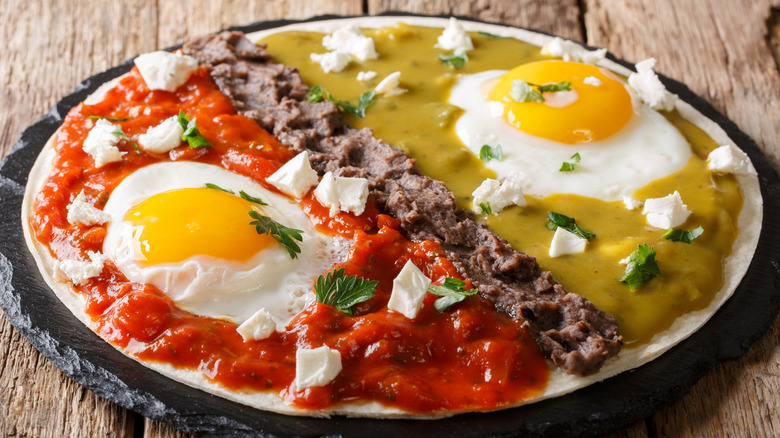What Makes Eggs 'Divorced' In The Popular Mexican Breakfast Dish
Huevos divorciados, or "divorced eggs," is a newer take on the historic Mexican breakfast dish, huevos rancheros, that is believed to have come about in Sonora or Puebla, Mexico after the original recipe was developed in the 16th century. While you may not be as familiar with this oddly-named Mexican breakfast dish, huevos divorciados rivals huevos rancheros in popularity both in and out of Mexico as it brings two distinct flavor profiles onto one plate while adding more complexity to the palate.
Huevos rancheros is a dish that piles all ingredients together in a one-pan recipe like one happy family; Huevos divorciados takes the opposite approach by preparing key components separately and deliberately plating them with clear lines of demarcation. It's an amicable divorce of flavors where two fried eggs and tortillas are the common bond.
Huevos divorciados is a complex dish that provides more versatility for chefs, allowing cooks to choose their favorite red and green salsa recipes for each fried egg. And although it requires significantly more preparation than huevos rancheros, the result is worth the effort.
Contrast and plating
While it may seem likely that huevos divorciados was created out of indecision, it may have been made for ranchers who needed a healthy meal to get through their challenging daily routines — just as huevos rancheros were at that time.
Huevos divorciados call for salsa roja and salsa verde poured over their respective fried eggs, often separated down the middle by a barrier of refried black beans, sliced avocado and red onions, tortilla chips, or breakfast potatoes. A foundation of tortillas and fried eggs is the same as huevos rancheros, with the divorce happening both visually and through different flavor profiles.
The visual divergence of red and green on opposite sides of the plate offers a stunning presentation and alludes to their separate yet equal contributions to the dish as a whole. You get the fresh, zesty, and herbaceous flavors of cilantro, green chilies, and tomatillos in salsa verde along with the spicy, smokey tomato and red chili-based salsa roja. However, by divorcing them on the plate, you get to taste each sauce separately, effectively upholding the integrity of both.
Components are made separately
Another way to interpret "divorced" in huevos divorciados is through the separate preparation of the sauces. Other recipes serve fresh tortillas on the side as opposed to placing fried tortillas under the eggs, further divorcing the dish's ingredients. You could even go as far as to cook each egg differently, plating a sunny-side-up egg next to an over-easy egg, for example.
Red and green sauces have completely different ingredients and are thus boiled and blended separately. Again, this is a labor of love that requires significant prep time for both salsas. That said, you can streamline the process by making both salsas simultaneously on different burners. You can also make the salsas ahead of time and use any leftovers to garnish other famous Mexican breakfasts like homemade chilaquiles or breakfast tacos.
Despite the sad connotation huevos divorciados invokes, any Mexican food lover will support this gastronomical divorce, After all, it ultimately brings more flavors to the breakfast table.


